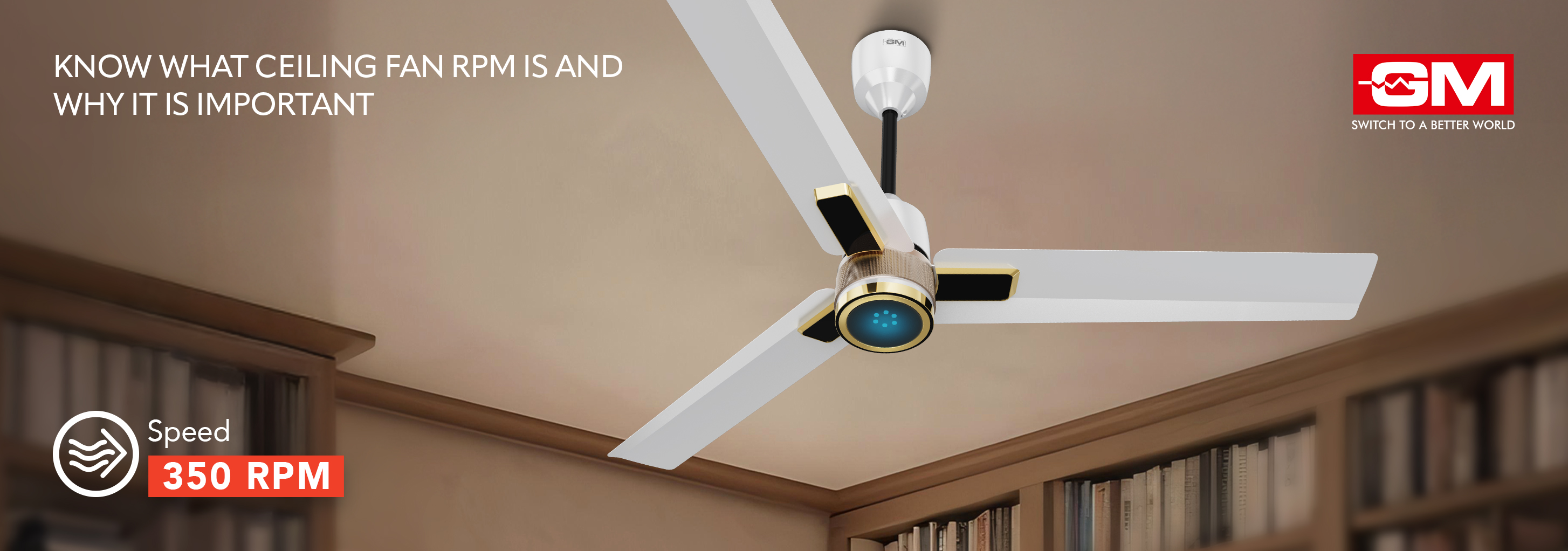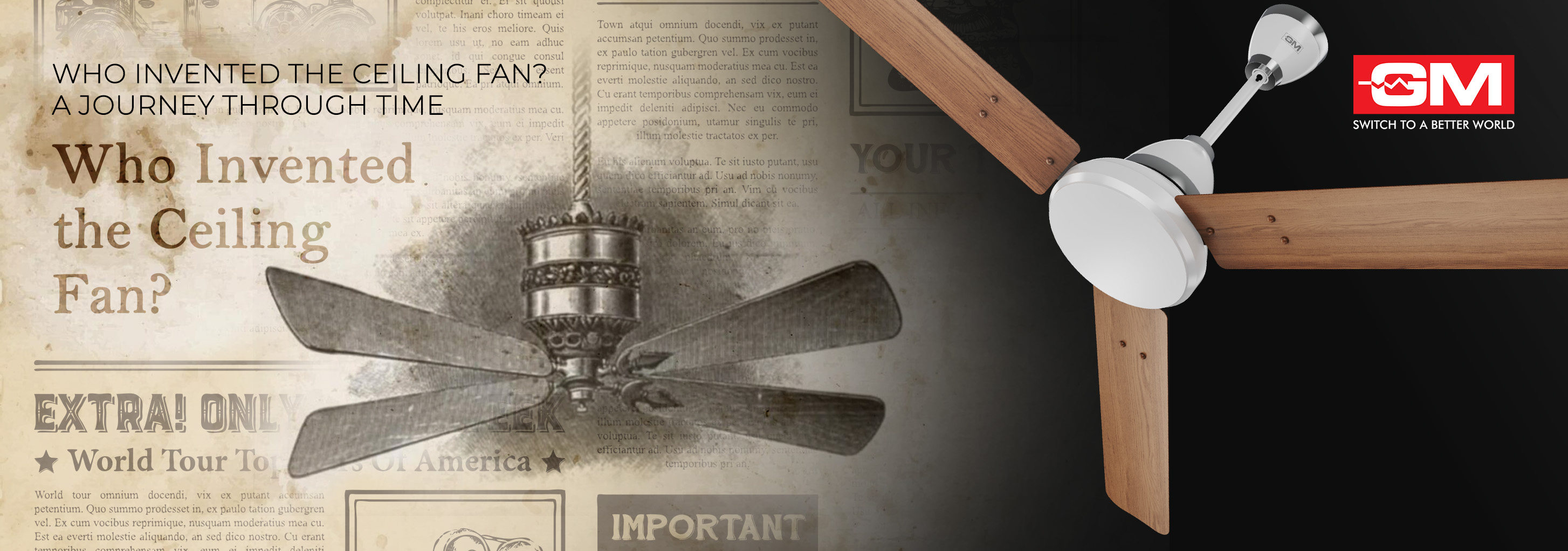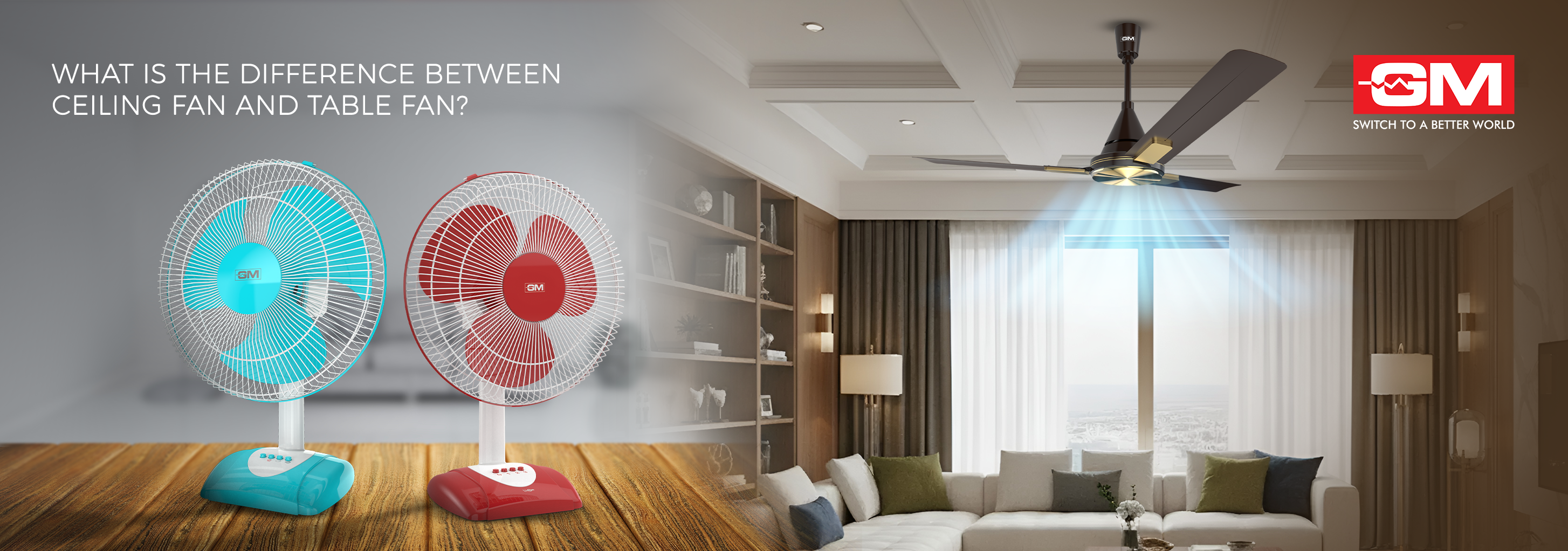Blog
Know What Ceiling Fan RPM Is and Why It Is Important
Updated on Jul 2025

A high RPM ceiling fan is an absolute essential appliance to maintain a cool indoor temperature. They are a great alternative to air conditioners. However, a crucial yet often overlooked aspect of a fan's performance is its RPM. The ceiling fan RPM is a critical factor that determines its efficiency and functioning. Understanding the ceiling fan RPM speed can help consumers select the most efficient and suitable fans for their elegant home spaces.
What is RPM in Ceiling Fans?
RPM stands for Revolutions Per Minute. It denotes the number of times a fan’s blades complete a full rotation in one minute. This metric influences the fan’s ability to circulate air effectively across the room. A high RPM ceiling fan has the capability to spin the blades faster and deliver more air for effective cooling. On the other hand, a ceiling fan with low RPM creates a gentler flow of air across the room and is ideal in rooms where rapid cooling is not required.
Why is RPM Important in Ceiling Fans?
Making the right choice of ceiling fan can make a huge difference in moving air across the room, thus making the room comfortable for living. Here’s why you must know the importance of ceiling fan RPM.
Energy Consumption
Ceiling fans with low performance and high energy consumption are simply undesirable in any household or office space. Having a keen understanding of RPM in fans allows you to choose the best RPM ceiling fan that balances performance with energy efficiency.
Noise Levels
Ceiling fans in bedrooms and living rooms are meant to radiate a cool breeze across the space and enhance your living experience. Ceiling fans with high RPM and optimised motor efficiency make less noise and deliver more cool air which helps you relax peacefully.
Maintain Air Circulation Efficiency
Due to its superior design, a ceiling fan with high RPM and speed facilitates better air movement for a longer duration of time, thus ensuring the room is cooled more effectively.
Factors Influencing Ceiling Fan RPM
The RPM of a ceiling fan is influenced by several factors. Let’s take a closer look at them.
Blade Design
The blade design of a ceiling fan plays an important role in determining its airflow across the room. Ceiling fan blades with wider tips tend to have higher RPM and circulate more air compared to ceiling fans with traditional blade design. For instance, GM Modular’s G-Storm is known for its supreme air delivery owing to the wider tip of its blades.
Blade Number
A ceiling fan with fewer blades can rotate faster, thus resulting in higher revolutions per minute. There is less friction involved in a ceiling fan with three blades than in a ceiling fan with five blades.
Fan Motor Power and Efficiency
Most modern ceiling fans are equipped with BLDC technology and a sturdy motor function that ensures swift airflow movement across every corner of the room. A ceiling fan with a high powered motor provides better torque in revolution thus providing higher RPM in a ceiling fan. Besides, a ceiling fan with a BLDC powered motor is less noisy and results in smoother operations than ceiling fans with conventional motors.
Blade Drag and Aerodynamics
The high RPM ceiling fans available today have advanced aerodynamic designs that help to minimise the drag on blades while they rotate, thus encouraging a smooth and faster rotation. A few high RPM ceiling fans have slightly curved blades, called blade pitch, that minimise the air resistance and maximise RPM without compromising the air quality in the room.
Dimensions of the Room
The ceiling fan’s height and the size of the room have a direct impact on its speed and performance. A fan with high RPM is ideal for smaller rooms that require an immediate cooling effect. A fan with wider blades and moderate RPM is a great choice for larger rooms that require consistent and balanced airflow.
External Environmental Conditions
Environmental conditions such as room temperature, humidity, and proximity to the sea also impact the fan’s RPM performance. A high RPM ceiling fan is quite useful in homes with a hot and humid climate as it circulates air faster, thus creating a cooler environment quickly. Whereas, a ceiling fan with moderate RPM is recommended for homes where the climate generally remains cooler than hotter regions.
Best RPM Ceiling Fan for Rooms of Different Sizes
Not all ceiling fans with high RPMs will fit into every room. Based on the room size, here are a few choices of ceiling fan RPM you can select from.
1. Bedrooms:
For bedrooms, a ceiling fan with an RPM of 300-350 offers gentle airflow that helps the individual get a comfortable and peaceful sleep.
2. Living Rooms:
Living rooms have a moderate to large space size. For such spaces, the normal RPM of the ceiling fan lies between 350-450, which provides adequate circulation.
3. Large Halls:
Ceiling fans with RPMs higher than 400 are ideal for enlarged spaces with a large area that requires robust airflow across the space.
Also, check out our blog on the Ceiling Fan Size Guide to Help You Choose the Right‑Sized Fan.
Steps to Select the Right RPM Ceiling Fan
Consider the following points while selecting a ceiling fan with the best RPM that matches your home’s needs.
1. Evaluate your Room’s Size
The ceiling fan you select will depend on the size of the room where it will be installed. As per the room size stated above, look for ceiling fans with suitable RPMs that provide adequate cooling impact.
2. Measure the Ceiling Height
For rooms with a large ceiling height, consider a high RPM ceiling fan with downrods for optimal performance and sufficient cooling effect across the room. However, for rooms with low ceilings, look for flush mount fans since they provide high RPM without compromising on safety.
3. Prioritise Your Needs
Look for energy efficient ceiling fans that are powered by modern BLDC technology. These ceiling fans blend low energy consumption with high RPM and performance, thus reducing the burden of electricity bills.
4. Choose the Appropriate Ceiling Fan
Once you have an idea of the room’s size, ceiling height, and your specific cooling needs, look for the latest models of ceiling fans with high RPM that make your home a haven.
Every home has unique cooling needs. Knowing the nuances of ceiling fan RPM is essential for selecting the right fan that meets the specific cooling needs while being efficient and maintaining energy consumption. With the wide range of GM Modular ceiling fans, experience optimal airflow, a faster cooling effect, and an unmatched living experience that can be found only at your home with the right ceiling fan.
Curious about how a ceiling fan works? Learn more in our blog on the Different Parts of Ceiling Fans
Frequently Asked Questions
1. What is a good RPM for a ceiling fan?
A. A ceiling fan with an RPM between 200-300 is considered decent as it provides a comfortable breeze across the room without generating too much noise or consuming significantly higher power.
2. Is the ceiling fan RPM important?
A. Yes. Determining the RPM of the ceiling fan helps you make informed decisions about the right choice of fan that meets the unique needs of the rooms in your home.
3. Is a higher RPM better for fans?
A. It is not necessary that ceiling fans must have higher RPM. Although it is desired, the speed of the ceiling fan depends on other factors like the blade size, its width, motor efficiency, and the technology enabled in the fan. It is always recommended to look for other features in addition to the ceiling fan RPM.
4. What should I look for while buying a ceiling fan?
It is best to look for overall features of the ceiling fan, such as the blade design, its size, and width, the material of the blade, the technology used, and the blade pitch, since all the features contribute to the efficient functioning of a ceiling fan.
Related Blogs

Who Invented the Ceiling Fan? A Journey Through Time
Ceiling fans are a quiet yet transformative part of life at home, offering comfort, style, and energy savings all year round. But not many of us know about the invention of the ceiling fan and how this humble device revolutionised modern living. To a
Read More
What is the Difference Between a Ceiling Fan and a Table Fan?
Fans are easy to use and save energy, so most people use them to keep a room cool and comfortable. But before you buy one, you should know what makes a ceiling fan different from a table fan. They both move air, but they do it in very different ways
Read More
Types of Doorbells Explained: Wired, Wireless, Smart, and More
A doorbell is one of the most important parts of a home or office, but it's also one of the most common things that people forget about. It not only lets visitors know you're home, but it also makes your space more convenient, safe, and stylish. The
Read More
How to Use a Steam Iron Safely and Effectively?
No matter if you're going to work, a meeting, or a party, wearing a crisp, wrinkle-free outfit can boost your confidence right away. But you need to know how to use a steam iron correctly to get that perfect finish. A steam iron isn't just another ap
Read More